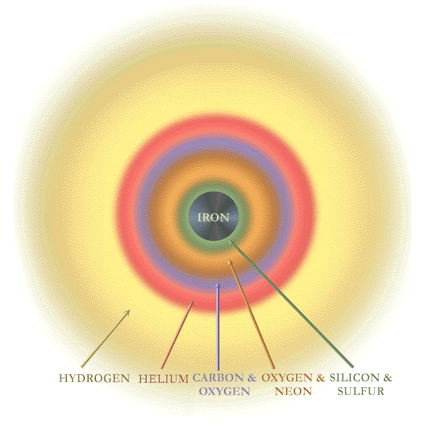5. CORE COLLAPSE SUPERNOVAE
Single stars born with mass less than about 8 times the Sun all have the same fate as the Sun. After they become a red giant the second time (the AGB stage), they will expel most of their mass into outer space. The carbon/oxygen core that remains will be less massive than 1.4 times the Sun (the Chandrasekhar limit), and so will stop collapsing. The remaining star will become a white dwarf. The outer part of the star that was expelled into interstellar space will remain visible for some 20,000 - 50,000 years as a planetary nebula, then fade away as it becomes more distended and the central white dwarf star cools off and becomes less luminous. Thus, all single stars with initial mass less than about 8 times the Sun will end up as white dwarf stars.
But if the star is born with more than 8 solar masses, its carbon/oxygen
core will be more massive than 1.4 times the Sun and so cannot stop collapsing.
Instead, it will continue to collapse and become even hotter. When the core
temperature reaches several hundred millions of degrees, the carbon and oxygen
will begin to fuse to form even heavier elements such as silicon, calcium, and
iron. But since the fusion of carbon and oxygen into heavier elements does not
release very much energy, these reactions cannot long delay the star's final
reckoning. For details of this evolution, see Evolution
of High Mass Stars by Richard Pogge of Ohio State University.
|

|
|
The internal structure of a massive star just before core collapse. At the innermost shell, silicon and sulfur burn to produce iron adding mass to the iron core. Not to scale: the iron core is smaller than the Earth, while the outer hydrogen envelope has a diameter greater than the Earth's orbit. Source |
If the core of a star is more massive than 1.4 solar masses and has become mostly iron, there is no pressure that can stop it from collapsing. And that is exactly what it will do. It becomes so hot and dense that the iron nuclei begin to "melt" and become helium again, then hydrogen. This melting process consumes energy and removes pressure from the core of the star. Then gravity takes over, and the core collapses. In less than 1/10 second, the core of the star collapses to a radius of about 20 km and its density rises to that of the atomic nucleus. The hydrogen nuclei (protons) absorb electrons and become neutrons, releasing neutrinos in the process. The closely packed neutrons can exert an outward pressure sufficient to stop the collapse.
Before the collapse stops, the core is falling in at something like 10% of the speed of light. The thunderclap resulting from the sudden stop releases an enormous amount of energy, most (about 99%) of which escapes in the form of neutrinos. But about 1% of the neutrino energy is absorbed by the infalling gas, causing a tremendous rebound explosion that we call a Core Collapse Supernova (also called a Type II Supernova). For a few months, the star becomes as luminous as a billion Suns.
Professor Adam Burrows of the University of Arizona has simulated
this process on a supercomputer. This movie
shows how the neutrinos heat the infalling gas and cause the explosion. You
will first see dense gas (shown as blue) falling in. Then, after about 0.2 seconds,
the infall is halted at the center and a hot ball of neutrons (shown as yellow)
forms there. Matter continues to fall onto the surface of the neutron ball.
But near the surface, the infalling material is heated by the neutrinos and
begins to boil. As the heating increases, the boiling becomes more violent and
the boiling layer thickens. Finally, about 1/3 second after the collapse begins,
the boiling layer begins to expand suddenly, reversing the infall and creating
the explosion. For a detailed description of these processes, see Core
Collapse Supernovae by Mike Guidry of Oak Ridge National Laboratory.
This is the story of core collapse supernovae that most astrophysicists
believe today. But if you read Dr. Guidry's site, you will see that we have
a long way to go before we can say that they really understand core collapse
supernovae. For example, the theoretical calculations do not explain why the
energy imparted to the exploding matter is about 1% of the energy released in
the form of of neutrinos (instead of, say, 0.1% or 10%). In fact, in some computer
simulations of core collapse, no explosion ensues. It seems that the explosion
depends on a subtle combination of rapid convection driven by neutrino heating
from the core. To simulate these processes realistically requires calculations
that are at the very limit of the capabilities of the best supercomputers. Even
to do that, astrophysicists must make approximations to the actual physical
processes that we believe occur under these extreme circumstances.
What is left behind after the explosion? It's called a neutron star -- a ball a million times as massive as the entire Earth, compressed to a few miles in diameter. Its average density will be about 1014 times that of water. Put it this way: a cupful of neutron star material weighs more than the entire Long's Peak mountain! Incredible? Not quite! As you will see in Lesson 7, astronomers have discovered hundreds of neutron stars. They are absolutely real -- as real as the Earth beneath your feet!
(Return to course home page)
Last modified February 23, 2002
Copyright by Richard McCray
